Abstract
OBJECTIVES--To evaluate the role of a treadmill stress test for identifying patients at risk of recurrent ischaemic events after acute myocardial infarction treated by thrombolysis. BACKGROUND--The natural history of myocardial infarction has changed with the introduction of thrombolytic treatment; there is a lower mortality but a higher incidence of recurrent thrombotic events (reinfarction, unstable angina). The treadmill stress continues to be recommended for risk stratification after acute myocardial infarction even though its value has never been formally reassessed in the thrombolytic era. METHODS--Prospective observational study in which 256 consecutive patients who presented with acute myocardial infarction treated by thrombolysis underwent an early treadmill stress test and were followed up for 10 (range 6-12) months. RESULTS--Recurrent ischaemic events occurred in 41 patients (unstable angina 15, reinfarction 21, death five) and a further 21 required revascularisation. Both ST depression at a low workload and low exercise tolerance (< 7 metabolic equivalents of the task (METS) were predictive of recurrent events, with respective hazard ratios of 1.93 (95% confidence interval (95% CI) 1.17-3.20; p < 0.01)) and 1.67 (95% CI 1.0-2.78; p < 0.05). These variables identified 50% and 70% of patients who subsequently sustained a recurrent ischaemic event, but the corresponding values for positive predictive accuracy were only 26% and 21%. Thus they are of limited value as a screening measure for identifying patients likely to benefit from invasive investigation and revascularisation. None of the other variables (ST elevation, haemodynamic responses, ventricular extrasystoles, angina) was significantly associated with recurrent ischaemic events. CONCLUSIONS--The treadmill stress test is of limited value for identifying patients at risk of recurrent ischaemic events after acute myocardial infarction treated by thrombolysis.
Full text
PDF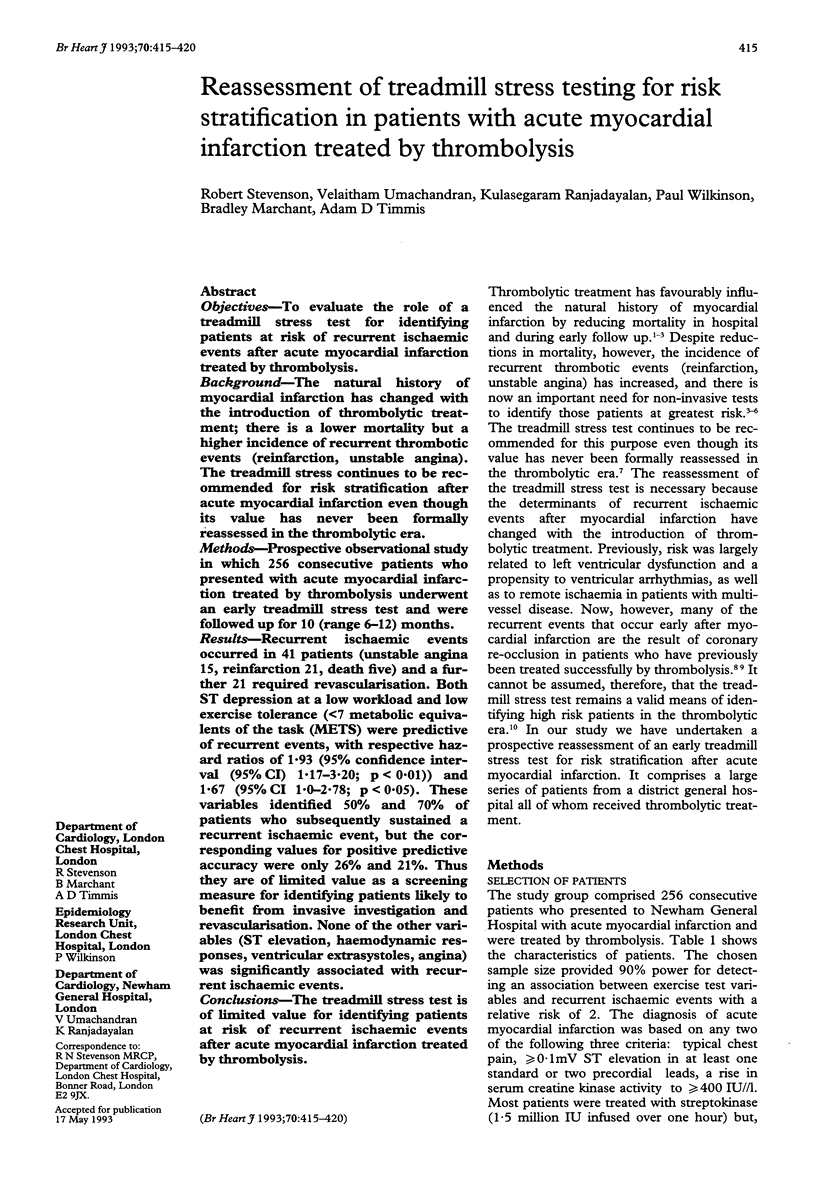
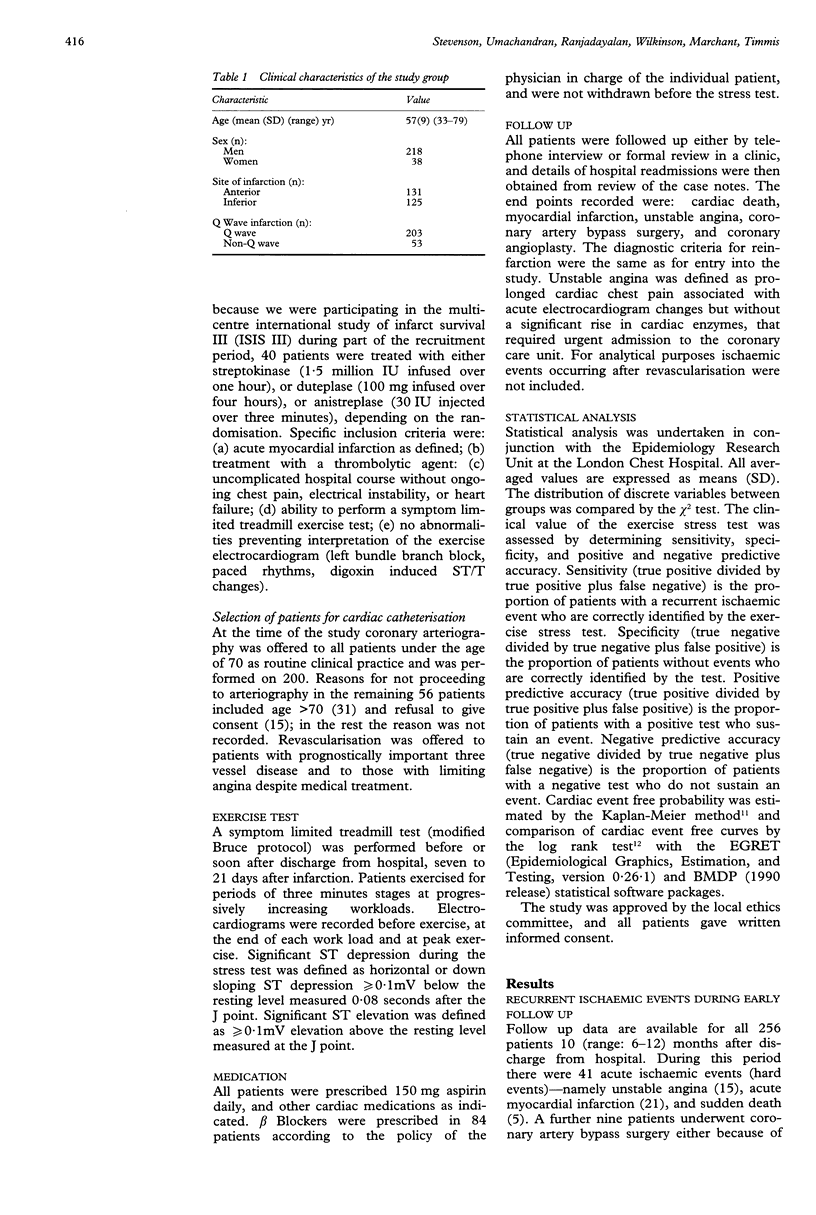

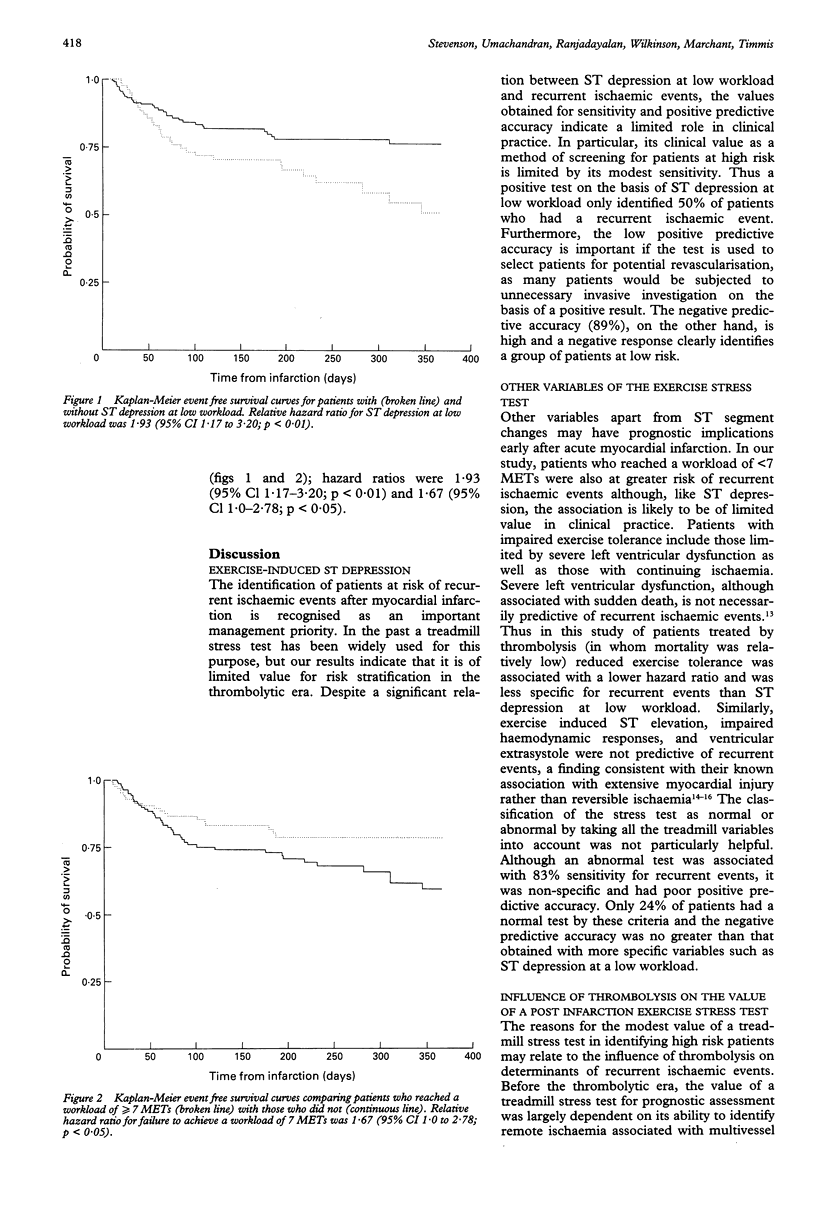
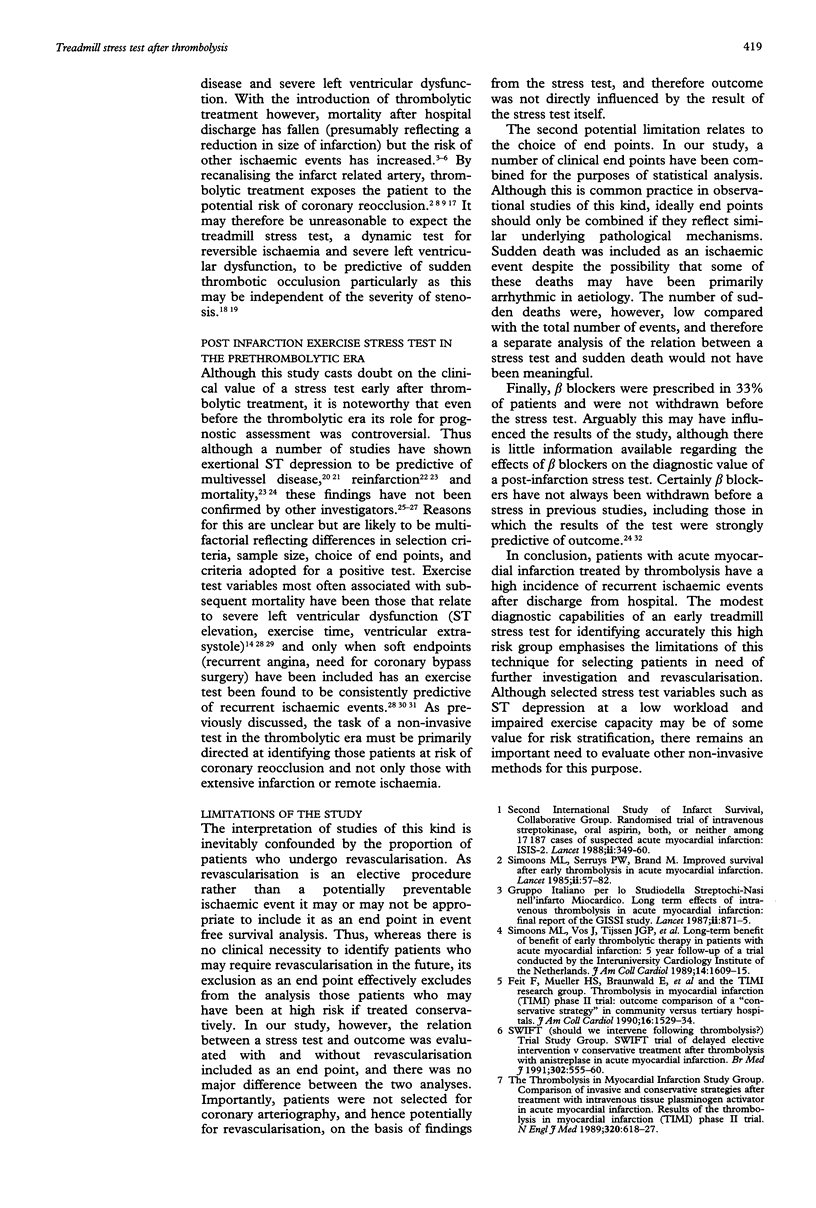
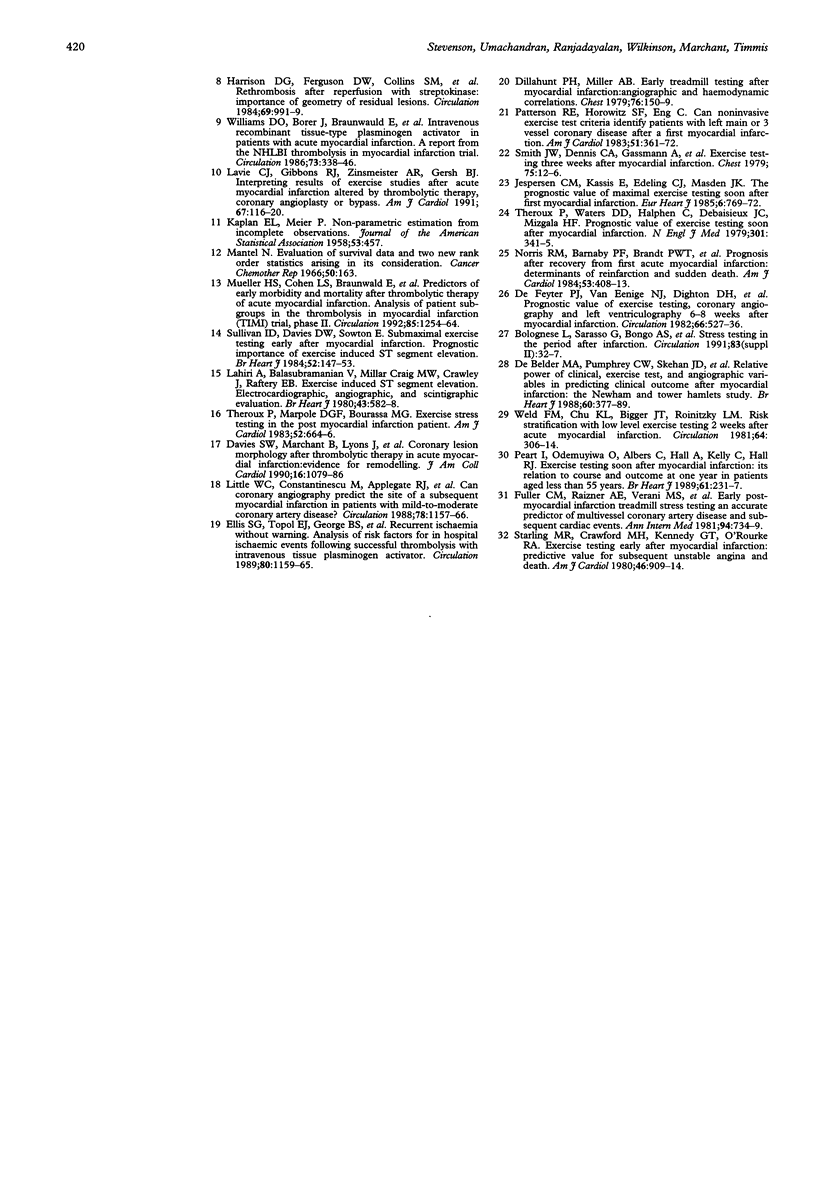
Selected References
These references are in PubMed. This may not be the complete list of references from this article.
- Davies S. W., Marchant B., Lyons J. P., Timmis A. D., Rothman M. T., Layton C. A., Balcon R. Coronary lesion morphology in acute myocardial infarction: demonstration of early remodeling after streptokinase treatment. J Am Coll Cardiol. 1990 Nov;16(5):1079–1086. doi: 10.1016/0735-1097(90)90535-w. [DOI] [PubMed] [Google Scholar]
- De Feyter P. J., van Eenige M. J., Dighton D. H., Visser F. C., de Jong J., Roos J. P. Prognostic value of exercise testing, coronary angiography and left ventriculography 6--8 weeks after myocardial infarction. Circulation. 1982 Sep;66(3):527–536. doi: 10.1161/01.cir.66.3.527. [DOI] [PubMed] [Google Scholar]
- Dillahunt P. H., 2nd, Miller A. B. Early treadmill testing after myocardial infarction: Angiographic and hemodynamic correlations. Chest. 1979 Aug;76(2):150–155. doi: 10.1378/chest.76.2.150. [DOI] [PubMed] [Google Scholar]
- Ellis S. G., Topol E. J., George B. S., Kereiakes D. J., Debowey D., Sigmon K. N., Pickel A., Lee K. L., Califf R. M. Recurrent ischemia without warning. Analysis of risk factors for in-hospital ischemic events following successful thrombolysis with intravenous tissue plasminogen activator. Circulation. 1989 Nov;80(5):1159–1165. doi: 10.1161/01.cir.80.5.1159. [DOI] [PubMed] [Google Scholar]
- Ethical issues debated by BMA. Lancet. 1985 Jul 6;2(8445):57–57. [PubMed] [Google Scholar]
- Feit F., Mueller H. S., Braunwald E., Ross R., Hodges M., Herman M. V., Knatterud G. L. Thrombolysis in Myocardial Infarction (TIMI) phase II trial: outcome comparison of a "conservative strategy" in community versus tertiary hospitals. The TIMI Research Group. J Am Coll Cardiol. 1990 Dec;16(7):1529–1534. doi: 10.1016/0735-1097(90)90295-z. [DOI] [PubMed] [Google Scholar]
- Fuller C. M., Raizner A. E., Verani M. S., Nahormek P. A., Chahine R. A., McEntee C. W., Miller R. R. Early post-myocardial infarction treadmill stress testing. An accurate predictor of multivessel coronary disease and subsequent cardiac events. Ann Intern Med. 1981 Jun;94(6):734–739. doi: 10.7326/0003-4819-94-6-734. [DOI] [PubMed] [Google Scholar]
- Harrison D. G., Ferguson D. W., Collins S. M., Skorton D. J., Ericksen E. E., Kioschos J. M., Marcus M. L., White C. W. Rethrombosis after reperfusion with streptokinase: importance of geometry of residual lesions. Circulation. 1984 May;69(5):991–999. doi: 10.1161/01.cir.69.5.991. [DOI] [PubMed] [Google Scholar]
- Jespersen C. M., Kassis E., Edeling C. J., Madsen J. K. The prognostic value of maximal exercise testing soon after first myocardial infarction. Eur Heart J. 1985 Sep;6(9):769–772. doi: 10.1093/oxfordjournals.eurheartj.a061939. [DOI] [PubMed] [Google Scholar]
- Lahiri A., Balasubramanian V., Millar Craig M. W., Crawley J., Raftery E. B. Exercise-induced ST segment elevation. Electrocardiographic, angiographic, and scintigraphic evaluation. Br Heart J. 1980 May;43(5):582–588. doi: 10.1136/hrt.43.5.582. [DOI] [PMC free article] [PubMed] [Google Scholar]
- Lavie C. J., Gibbons R. J., Zinsmeister A. R., Gersh B. J. Interpreting results of exercise studies after acute myocardial infarction altered by thrombolytic therapy, coronary angioplasty or bypass. Am J Cardiol. 1991 Jan 15;67(2):116–120. doi: 10.1016/0002-9149(91)90431-j. [DOI] [PubMed] [Google Scholar]
- Little W. C., Constantinescu M., Applegate R. J., Kutcher M. A., Burrows M. T., Kahl F. R., Santamore W. P. Can coronary angiography predict the site of a subsequent myocardial infarction in patients with mild-to-moderate coronary artery disease? Circulation. 1988 Nov;78(5 Pt 1):1157–1166. doi: 10.1161/01.cir.78.5.1157. [DOI] [PubMed] [Google Scholar]
- Mantel N. Evaluation of survival data and two new rank order statistics arising in its consideration. Cancer Chemother Rep. 1966 Mar;50(3):163–170. [PubMed] [Google Scholar]
- Mueller H. S., Cohen L. S., Braunwald E., Forman S., Feit F., Ross A., Schweiger M., Cabin H., Davison R., Miller D. Predictors of early morbidity and mortality after thrombolytic therapy of acute myocardial infarction. Analyses of patient subgroups in the Thrombolysis in Myocardial Infarction (TIMI) trial, phase II. Circulation. 1992 Apr;85(4):1254–1264. doi: 10.1161/01.cir.85.4.1254. [DOI] [PubMed] [Google Scholar]
- Norris R. M., Barnaby P. F., Brandt P. W., Geary G. G., Whitlock R. M., Wild C. J., Barratt-Boyes B. G. Prognosis after recovery from first acute myocardial infarction: determinants of reinfarction and sudden death. Am J Cardiol. 1984 Feb 1;53(4):408–413. doi: 10.1016/0002-9149(84)90003-1. [DOI] [PubMed] [Google Scholar]
- Patterson R. E., Horowitz S. F., Eng C., Meller J., Goldsmith S. J., Pichard A. D., Halgash D. A., Herman M. V., Gorlin R. Can noninvasive exercise test criteria identify patients with left main or 3-vessel coronary disease after a first myocardial infarction? Am J Cardiol. 1983 Feb;51(3):361–372. doi: 10.1016/s0002-9149(83)80066-6. [DOI] [PubMed] [Google Scholar]
- Peart I., Odemuyiwa O., Albers C., Hall A., Kelly C., Hall R. J. Exercise testing soon after myocardial infarction: its relation to course and outcome at one year in patients aged less than 55 years. Br Heart J. 1989 Mar;61(3):231–237. doi: 10.1136/hrt.61.3.231. [DOI] [PMC free article] [PubMed] [Google Scholar]
- Simoons M. L., Vos J., Tijssen J. G., Vermeer F., Verheugt F. W., Krauss X. H., Cats V. M. Long-term benefit of early thrombolytic therapy in patients with acute myocardial infarction: 5 year follow-up of a trial conducted by the Interuniversity Cardiology Institute of The Netherlands. J Am Coll Cardiol. 1989 Dec;14(7):1609–1615. doi: 10.1016/0735-1097(89)90003-x. [DOI] [PubMed] [Google Scholar]
- Smith J. W., Dennis C. A., Gassmann A., Gaines J. A., Staman M., Phibbs B., Marcus F. I. Exercise testing three weeks after myocardial infarction. Chest. 1979 Jan;75(1):12–16. doi: 10.1378/chest.75.1.12. [DOI] [PubMed] [Google Scholar]
- Starling M. R., Crawford M. H., Kennedy G. T., O'Rourke R. A. Exercise testing early after myocardial infarction: predictive value for subsequent unstable angina and death. Am J Cardiol. 1980 Dec 1;46(6):909–914. doi: 10.1016/0002-9149(80)90344-6. [DOI] [PubMed] [Google Scholar]
- Sullivan I. D., Davies D. W., Sowton E. Submaximal exercise testing early after myocardial infarction. Prognostic importance of exercise induced ST segment elevation. Br Heart J. 1984 Aug;52(2):147–153. doi: 10.1136/hrt.52.2.147. [DOI] [PMC free article] [PubMed] [Google Scholar]
- Théroux P., Marpole D. G., Bourassa M. G. Exercise stress testing in the post-myocardial infarction patient. Am J Cardiol. 1983 Oct 1;52(7):664–667. doi: 10.1016/0002-9149(83)90393-4. [DOI] [PubMed] [Google Scholar]
- Théroux P., Waters D. D., Halphen C., Debaisieux J. C., Mizgala H. F. Prognostic value of exercise testing soon after myocardial infarction. N Engl J Med. 1979 Aug 16;301(7):341–345. doi: 10.1056/NEJM197908163010701. [DOI] [PubMed] [Google Scholar]
- Weld F. M., Chu K. L., Bigger J. T., Jr, Rolnitzky L. M. Risk stratification with low-level exercise testing 2 weeks after acute myocardial infarction. Circulation. 1981 Aug;64(2):306–314. doi: 10.1161/01.cir.64.2.306. [DOI] [PubMed] [Google Scholar]
- Williams D. O., Borer J., Braunwald E., Chesebro J. H., Cohen L. S., Dalen J., Dodge H. T., Francis C. K., Knatterud G., Ludbrook P. Intravenous recombinant tissue-type plasminogen activator in patients with acute myocardial infarction: a report from the NHLBI thrombolysis in myocardial infarction trial. Circulation. 1986 Feb;73(2):338–346. doi: 10.1161/01.cir.73.2.338. [DOI] [PubMed] [Google Scholar]
- de Belder M. A., Pumphrey C. W., Skehan J. D., Rimington H., al Wakeel B., Evans S. J., Rothman M., Mills P. G. Relative power of clinical, exercise test, and angiographic variables in predicting clinical outcome after myocardial infarction: the Newham and Tower Hamlets study. Br Heart J. 1988 Nov;60(5):377–389. doi: 10.1136/hrt.60.5.377. [DOI] [PMC free article] [PubMed] [Google Scholar]


